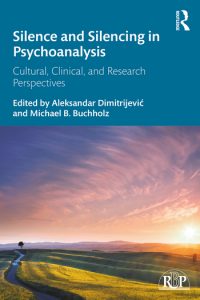Cultural Function and Psychological Transformation of Silence in Psychoanalysis and Psychotherapy
by Elsa Ronningstam, PhD
Abstract
Cultural experience of silence and individual vicissitudes between talking and being silent influence the way individuals form an alliance and pursue the analytic process. This is of relevance both for the patient and for the psychoanalyst/therapist. The author describes a patient, whose silent phase occurred in the fifth and sixth year of intensive psychoanalytic psychotherapy. She suggests that a) the silence functioned as a protection of a space for the core self and promoted inner transformation and psychological development; b) the silence involved a transference-countertransference matrix with projective identifications of the patient’s internalized mother- and father-related objects that caused a tenuous balance between maintaining and erasing the relationship between the patient and the author; c) the silence phase was highly influenced by the author’s own cultural background and what she brought into the relationship of tolerance of being silent in the presence of another, and understanding of the many complex functions of silence. During the silent phase the patient moved from simply describing and naming her affects and inner experiences or expressing them as somatic processes, to being able to internally access and verbally convey her own affects and experiences in the therapeutic alliance. This process involved both affect desomatization, affect differentiation, and affect verbalization.
Dimitrijevic, A. and Buchholz, M.B., eds. (2021). Silence and Silencing in Psychoanalysis: Cultural, Clinical, and Research Perspectives. Routledge, pp. 105-127.
Link to Online Publication [fulltext can be requested from the library].
Note: A version of this article entitled Silence – Cultural Function and Psychological Transformation in Psychoanalysis and Psychotherapy appeared earlier in The International Journal of Psychoanalysis, 87(5): 1277-1295, 2006. The book editors decided to reprint this “possibly the best known and frequently quoted paper on silence in psychoanalysis in the last 20 years. It offers an overview of the cross-cultural meanings of silence and the review of psychoanalytic literature on silence, yet its central part is a detailed case presentation…”
About the Book

This book is the first comprehensive treatment in recent decades of silence and silencing in psychoanalysis from clinical and research perspectives, as well as in philosophy, theology, linguistics, and musicology. It approaches silence and silencing on three levels. First, it provides context for psychoanalytic approaches to silence through chapters about silence in phenomenology, theology, linguistics, musicology, and contemporary Western society. Its central part is devoted to the position of silence in psychoanalysis: its types and possible meanings (a form of resistance, in countertransference, the foundation for listening and further growth), based on both the work of the pioneers of psychoanalysis and on clinical case presentations. Finally, the book includes reports of conversation analytic research of silence in psychotherapeutic sessions and everyday communication. Not only are original techniques reported here for the first time, but research and clinical approaches fit together in significant ways. Members and partners can borrow the book from the BPSI library.
About the Author

Elsa Ronningstam, PhD is an Associate Professor of Psychology at Harvard Medical School and a Clinical Psychologist at McLean Hospital in Belmont, Massachusetts. She is a member of the faculty at the Boston Psychoanalytic Society and Institute and a member of the Boston Suicide Study Group. She has published and presented extensively nationally and internationally on topics related to studies and treatment of suicide and personality disorders. Her other recent publications, Psychotherapeutic Treatment of Depressive Symptoms in Patients with Narcissistic Disturbances and Internal Processing in Patients with Pathological Narcissism or Narcissistic Personality Disorder: Implications for Alliance Building and Therapeutic Strategies appeared in the Journal of Contemporary Psychotherapy and in the Special Issue of the Journal of Personality Disorders devoted to narcissism.
Previous Posts:
Paola M. Contreras, PsyD (2021). The Magical and the My-Person in Psychoanalysis During the Covid Pandemic. Journal of the American Psychoanalytic Association, 68(6): 1113-1126. Open Access, DOI: 10.1177/0003065120981733
Don R. Lipsitt, MD (2020). In Freud’s Pocket: A Totem of Medical Ambivalence? American Imago, 77(4): 738-751.
Rachel Brier, EdD and Anna Ornstein, MD (2020). Tracking Changes in the Disruption/Repair Sequences: Important Aspects of Clinical Work. Psychoanalysis, Self and Context.
Rodrigo Barahona, PsyaD (2020). Living the Non-Dream: An Examination of the Links Between Dreaming, Enactment, and Transformations in hallucinosis. The Psychoanalytic Quarterly, 89:4, 689-714.
Sarah Ackerman, PhD (2020). A Diagnosis for Psychoanalysis in the 21st Century: Freud as Medicine. The Psychoanalytic Quarterly, 89:4, 667-688.
Lora Tessman, PhD (2020). Review of Ghost in the Human Psyche: The Story of a ‘Muslim Armenian’ , by Vamik D. Volkan. Contemporary Psychoanalysis, 56(2-3):457-464.
Steven H. Cooper, PhD (2019). A Theory of the Setting: The Transformation of Unrepresented Experience and Play. The International Journal of Psychoanalysis, 100:6, 1439-1454.
Anton Hart, PhD (2020). Principles For Teaching Issues Of Diversity In A Psychoanalytic Context. Contemporary Psychoanalysis, 56:2-3, 404-417.
Lawrence J. Brown, PhD (2020). Trauma and Representation. The International Journal of Psychoanalysis, 100:6, 1154-1170.
Penelope Moore, LICSW (2020). Incest from a Young Age … Lasting a Lifetime. Psychodynamic Psychiatry, 48(1), 41-54.
Judith L. Kantrowitz, PhD (2020). A Psychoanalytic Memoir: The Analyst Enabled and Disabled by What is Personal. Journal of the American Psychoanalytic Association, 68(1), 83–100.
Cuneyt Iscan, MD (2020). Learning Along the Way: Further Reflections on Psychoanalysis and Psychotherapy by Patrick Casement, Routledge, Abingdon and New York, 2019, 156pp. American Journal of Psychoanalysis, 80:2, 235-239.
Click here to see a full archive of featured papers. All articles can be requested from the library.

